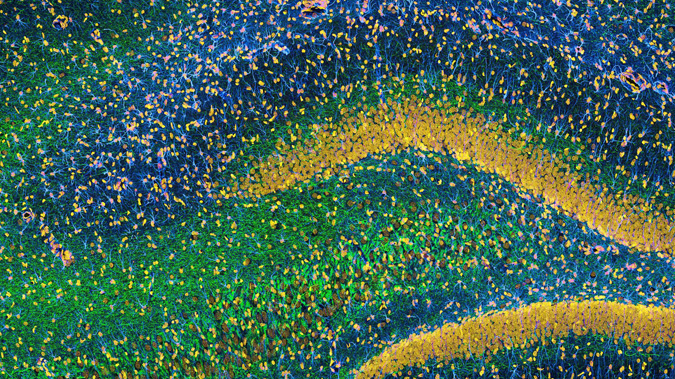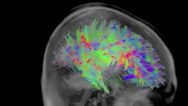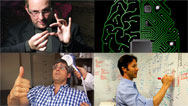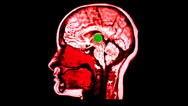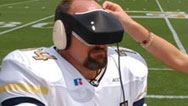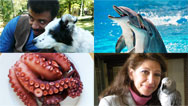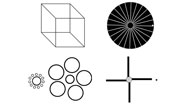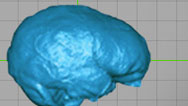
How Smart Can We Get?
See inside Einstein's brain, learn how to boost your memory, meet people who became savants after an injury, and more. Airing October 24, 2012 at 9 pm on PBS Aired October 24, 2012 on PBS
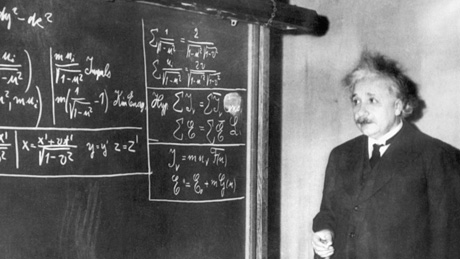
Program Description
Transcript
How Smart Can We Get?
PBS Airdate: October 24, 2012
DAVID POGUE (Host): How smart are you?
MEMORY CHAMPIONSHIP ANNOUNCER: Mental athletes, begin.
DAVID POGUE: Would you like to be smarter?
I feel like increasing my cortical tissue.
I'm David Pogue, and on this episode of NOVA scienceNOW,…
JOHN GOLFINOS (New York University Langone Medical Center): This is a real brain, a human brain.
DAVID POGUE: …I'm going to extremes…
Talk about a splitting headache.
…to unlock the secrets behind some of the most impressive brains around: from perhaps the greatest mind of the modern age,…
SANDRA WITELSON (Michael G. DeGroote School of Medicine, McMaster University): There's not one brain that has the same anatomy as Einstein.
DAVID POGUE: …to a guy who can remember impossibly long lists of numbers,…
CHESTER SANTOS (2008 United States Memory Champion): 418, 592, 597.
DAVID POGUE: Okay, that's highly freaky.
…to one with an amazing head for dates.
What day will Christmas fall on, in the year 2366?
GEORGE WIDENER (Calendar Calculator): Sunday.
DAVID POGUE: Come on, that's nuts!
What makes their brains so special?
Wait are you saying you can tell stuff about a person's brain by the outside?
DEAN FALK (School for Advanced Research, Santa Fe, New Mexico; Florida State University): Yes. And in the case of Einstein, one's definitely able to do that.
DAVID POGUE: Is genius born or made?
This is like an outtake from the Star Wars prop department.
We're diving under the hood …
JOY HIRSCH (Columbia University Medical Center): This slice here comes right across the top of his ears.
DAVID POGUE: …and revealing new evidence of what it means to be smart…
RICHARD HAIER (University of California, Irvine, Emeritus): We can now evolve the definition of intelligence.
DAVID POGUE: …and what you can do to improve your brainpower.
What does this mean? I'm going to find out. How Smart Can We Get? Up next, on NOVA scienceNOW.
Have you ever wondered why some brains are smarter than others or if there's a way to get smarter yourself? I'm David Pogue, and I'm on a quest to explore the upper limits of brainpower.
To start, I want to check out one of the smartest brains that ever existed: Albert Einstein's. There's no doubt, the guy was a genius. By his twenties, he had revolutionized our fundamental notions of space, time and matter with his theory of relativity. A few years later, he figured out how gravity works. As if that weren't mind-blowing enough, he came up with E=mc2.
Eventually, the great scientist moved here, to Princeton, New Jersey.
Can you take my picture?
And in his honor,…
FRED LEPORE (Robert Wood Johnson Medical School of the University of Medicine and Dentistry of New Jersey): Absolutely.
DAVID POGUE: … he's memorialized with this statue.
Not only that, there's a shrine dedicated to him in the back of a local clothing store.
Next you're going to tell me there's a Kennedy memorial behind the deli.
But what most residents don't know is that hidden inside this hospital is one of the best-kept secrets in America: …
FRED LEPORE: Over there.
DAVID POGUE: …Albert Einstein's brain.
Einstein's brain, the brain of the most famous scientist in the world is in there, and they won't let you in to see it?
FRED LEPORE: It's been there for a dozen years. I'm unable to get access to it. It is a very bizarre story.
DAVID POGUE: Neurologist Fred Lepore would love to get his hands on it. He hopes it will reveal what made Einstein so smart. Was there something different about his brain?
Believe it or not, we still have the chance to find out.
Okay, rewind a bit. Einstein dies.
FRED LEPORE: Einstein died on April 18, 1955. Thomas Harvey, the pathologist at the time, is expected to do a routine autopsy, routine autopsy.
DAVID POGUE: But instead, what Thomas Harvey, the doctor performing the autopsy, decides to do is anything but routine. Without consent from Einstein's family he decides to remove the brain.
So the doctor on duty, not his partner, not his brother, took the brain and, basically, kept it?
FRED LEPORE: Yes.
DAVID POGUE: And started to study it?
FRED LEPORE: Yes.
DAVID POGUE: Harvey takes dozens, possibly hundreds of photographs, knowing what's coming up next, because he's about to take the step you can't turn back from.
FRED LEPORE: He begins to dissect it, over the next few days, into 240 blocks.
DAVID POGUE: When you say a block you mean a little cube…
FRED LEPORE: A little cube.
DAVID POGUE: …of Albert Einstein's brain?
FRED LEPORE: Yeah. I can show you some, if you care to see.
DAVID POGUE: You can get in there?
FRED LEPORE: I have pictures.
These are the two glass cookie jars. We believe they hold about 180 blocks, although they weren't counted.
DAVID POGUE: You're talking about blocks of brain?
FRED LEPORE: Blocks of brain. Those little things that are sort of that yellowish putty color are sections of brain. And each section of brain is surrounded by gauze.
DAVID POGUE: If you had all the access you wanted, you would find out what, that he was a genius?
FRED LEPORE: You might find out he has some circuits that are different.
Is it standard issue or did Einstein really have a freakishly different brain.
DAVID POGUE: It becomes Thomas Harvey's life mission to find out. When he loses his job at Princeton Hospital, Harvey quietly slips away, taking the brain with him.
Can you imagine what the T.S.A. would have said about his carry-on? "Ah, sir, can you step over here?"
He travels to the Midwest. Wherever he moves, so goes the brain.
From time to time, he sends chunks of it to researchers he deems worthy. Then, in the 1990s, he sends several chunks and some of his photographs to Canadian neurologist Sandra Witelson.
Witelson has one of the largest collections of brains in the world, kept in this walk-in refrigerator.
SANDRA WITELSON: Thomas Harvey realized that because I had a large brain collection it would be a good comparison for a case study of Einstein's brain.
DAVID POGUE: Harvey gives Witelson a few select chunks. But it's in a handful of photographs that she finds the most valuable clues. She makes a startling discovery in an area of the brain called the parietal lobe, on the top of the head, towards the back.
SANDRA WITELSON: We have 125 brains in our collection, which means 250 hemispheres. There's not one hemisphere that has the same parietal lobe as Einstein.
DAVID POGUE: Witelson believes that a part of Einstein's parietal lobe was 15 percent larger than any other brain in her collection.
To find out what makes this discovery so important, I'm going where no host has gone before. With the help of pathologist David Zagzag and neurosurgeon John Golfinos, I'm taking a little brain tour.
So, gentlemen, can you certify this is no plastic model?
JOHN GOLFINOS (New York University Langone Medical Center): This is a real brain, a human brain.
DAVID POGUE: May I touch the brain?
JOHN GOLFINOS: Very gently.
DAVID POGUE: Oh, wow. It's cold, rubbery, and it's clammy, and it's got a weird consistency. How would you describe this to someone at home?
JOHN GOLFINOS: Like hard JELL-O is what I think it is.
DAVID POGUE: Yeah, very hard JELL-O, that's good.
Catch.
JOHN GOLFINOS: Put it down.
The first thing you notice, when you look at it, is that there's these raised parts, these ridges.
DAVID POGUE: These tiny ridges or bumps are called gyri. They contain billions of nerve cells.
The crevices are called sulci.
JOHN GOLFINOS: The reason we have all these folds is that, as the brain developed and as we got smarter, the brain got bigger. And to fit inside the skull it had to fold in on itself.
DAVID POGUE: Does that mean ancient man would not have as many folds?
JOHN GOLFINOS: Correct.
DAVID POGUE: More folds mean more nerve cells, and that means more brainpower. All of these folds are divided into four major areas, or lobes, which are found in both hemispheres. The area Witelson found unique in Einstein, the parietal lobe, is a fascinating part of the brain.
JOHN GOLFINOS: It's involved in how we develop a picture of the world around us. Three-D rotation, spatial imagining, that's what the parietal lobe does.
DAVID POGUE: Wow, so it kind of makes sense Einstein, who processed the universe and the laws of physics, should have a super-developed parietal lobe.
A unique parietal lobe could have helped Einstein think about space, time and gravity in a way nobody ever had before.
SANDRA WITELSON: That anatomy conferred some kind of an advantage to Einstein in that particular area of intelligence.
DAVID POGUE: But is that what made him a genius? Were his unique parietal lobes the key to his revolutionary mathematical concepts?
MICHAEL O'BOYLE (Texas Tech University): Wow, that's, like, a perfect score.
DAVID POGUE: At Texas Tech University, Michael O'Boyle is doing research that could help answer this question. He has been studying the brains of math geniuses, like 13-year-old Shyam.
SHYAM NARAYANAN (Math Genius): Einstein was a great scientist. So many others, Stephen Hawking, Newton, they were all really great scientists. I do want to be a great scientist like them.
DAVID POGUE: Shyam has won dozens of math competitions.
SHYAM NARAYANAN: Twelve square root of three.
MATH COMPETITION ANNOUNCER: Twelve root three is the correct answer.
DAVID POGUE: In fact, he's become a bit of a celebrity on the math circuit.
Today, Michael is scanning Shyam's brain to see what areas he uses to do complex math. This scan is called an f.M.R.I. The "f" stands for functional.
While Shyam presses buttons to answer math questions displayed on the screen, the scanner detects increased blood flow in the parts of his brain that are hard at work.
These areas are depicted as red.
How much is Shyam making use of his parietal lobes?
It turns out, a lot.
MICHAEL O'BOYLE: He is relying on parietal areas to determine these mathematical relationships. That's characteristic of lots of math-gifted types.
DAVID POGUE: In fact, in a recent study, O'Boyle found that, while solving math problems, math-gifted kids have five to six times more neuron activation in these brain regions than the average kid, especially here, in their parietal lobes.
But is there more?
My quest to find out takes me to Santa Fe, New Mexico, to learn what anthropologist Dean Falk has discovered in Einstein's brain.
Dean is a leading expert in the study of primate brains. Her specialty: analyzing the meaning of those bumps and folds on the surface.
Wait, are you saying you can tell stuff about a person's brain by the patterns of the folds on the outside?
DEAN FALK: Yes.
DAVID POGUE: And in the case of Einstein, one's definitely able to do that to some extent.
While looking at Witelson's photographs, Dean makes a surprising discovery in another area of Einstein's brain, the frontal lobes.
Doctors, talk to me about frontal.
JOHN GOLFINOS: So these frontal lobes are really involved in almost everything we do, making us who we are: behaviors, planning, understanding what we're going to do next, staying organized. They're really what make us human.
DAVID POGUE: They're very important, so I was curious to find out exactly what Dean discovered in Einstein's brain.
DEAN FALK: So in looking at these photographs, something jumped out at me. I noticed a particular feature in the frontal lobe on the right. I've got a K on it here that stands for knob. And would you like to know what part of the brain that controls?
DAVID POGUE: Why, yes, I would.
DEAN FALK: Well it's, right in front of…give me your hand. It's this. If you wiggle, wiggle your fingers, you are using this general area. It's the motor cortex for the left hand.
DAVID POGUE: So this area here, on the back of my right frontal lobe, is controlling my left hand.
DEAN FALK: Yes. And in the case of Einstein, it was greatly expanded and formed this knob, here, in the shaded area. And if you'd like to see on the brain, I'll show you where it would be if it were expanded in a human brain. It would be right about here, but notice this human doesn't have this knob.
And it turned out that I just read this study that talks about that knob and what it means.
DAVID POGUE: This study reported that musicians who learn how to play a stringed instrument in childhood, develop the same shape in exactly the same place. In fact, when they scanned kids with an M.R.I. before they learned to play a musical instrument, and then again, after 15 months of training, they discovered the brain had already changed.
DEAN FALK: So, I was surprised to see this in Einstein. And it fit, because, in fact, he took violin lessons as a child for years and years and years.
DAVID POGUE: Dean does some digging and discovers this.
DEAN FALK: When he was stuck on a physics problem, he would go into the kitchen and pick up the fiddle and play it to relax. And he would suddenly get an answer to a physics problem that he'd been working on.
DAVID POGUE: Wow.
Einstein is reported to have said: "The theory of relativity occurred to me by intuition, and music was the driving force behind that intuition."
Einstein may have been born with extraordinary parietal lobes, but without his love of the violin, would Einstein have become Einstein?
DEAN FALK: Einstein had the experiences in his life which allowed him to put to use a great brain. So both nature and nurture were really important for Einstein.
DAVID POGUE: With all this talk about brains, I was dying to find out more about my own. So I had some scans taken that show the surface of my brain and brought them to Dean to analyze.
I don't suppose it's too much to ask to ask if I have anything in common with Einstein?
DEAN FALK: Well, a very interesting question.
DAVID POGUE: Lo and behold, the same studies that show violinists develop a knob on the right side of their brains show that pianists develop something similar on the left.
DEAN FALK: I've been told that you do play piano.
DAVID POGUE: Yes.
DEAN FALK: And I want to ask you, did you…have you done this a long time?
DAVID POGUE: Yeah, since I was a kid.
DEAN FALK: How long? How long?
DAVID POGUE: I started when I was nine.
In fact, the piano is a big part of my life. I played through college, on Broadway, and I still play today.
DEAN FALK: Well, I'm not surprised, because this configuration fits with the findings of the study.
DAVID POGUE: I've developed an enlargement, right here, in my motor cortex on the left side of my brain, just as many other pianists do.
So I have reshaped my brain through piano lessons?
DEAN FALK: That is a reasonable hypothesis.
DAVID POGUE: But enough about me, let's get back to Albert. What the heck happened to his brain?
Before Thomas Harvey died, he returned those two cookie jars containing Einstein's brain here to Princeton Hospital, a stone's throw from Fred Lepore's reach.
So far, the hospital has declined Fred's requests for access, but he's determined to keep trying.
There's got to be a way…midnight heist?
FRED LEPORE: I'm open to any suggestions.
DAVID POGUE: Ocean's 14?
What did Edgar Allen Poe…
Karl Marx…
and Queen Victoria have in common?
Phrenology.
The idea?
Bumps on the skull revealed the size of 37 "brain organs."
Like:
Wit
Guile
Benevolence
One popular use?
Screening potential marriage partners.
Phrenology:
The eHarmony of the 19th century.
DAVID POGUE: Being smart involves many skills. Among them, how important is memory? To find out, I'm here at the U.S. Memory Championships.
U.S. MEMORY CHAMPIONSHIP ANNOUNCER: We have five minutes. Mental athletes, begin.
DAVID POGUE: First Round: memorize 500 numbers, in order, in just five minutes. Trying to remember more than 20 makes my head spin.
Nelson Dellis, a previous champion, memorizes 303 of them, making him the winner of this round.
Oh, come on. It's rigged. It's stacked against people with bad memories.
Next, I have five minutes to memorize the exact order of an entire deck of cards.
Maybe I'll get extra points for creativity, or not.
Of course Nelson beats everyone, recalling the order of the entire deck in 87 seconds.
Unbelievable, unbelievable! How smart is this guy? And how does he do it?
NELSON DELLIS (United States Memory Champion): I picture Olivia Newton dunking a helmet.
DAVID POGUE: Huh? Olivia Newton? Dunking a helmet?
Believe it or not, he's using an ancient technique that goes all the way back to 500 B.C.
So if I were to take this list…
I decide to put this memory technique to the test, so I invite Chester Santos, the 2008 U.S. Memory Champion, to use it to memorize a list of 60 numbers.
This would take me the rest of my life.
CHESTER SANTOS: I could definitely do this in five minutes or less.
DAVID POGUE: Go.
CHESTER SANTOS: Okay, I'm done. I got it.
DAVID POGUE: You're done?
CHESTER SANTOS: I got it. Yeah. Just let me know if I make any mistakes.
DAVID POGUE: Oh, you can count on it.
CHESTER SANTOS: 4…4, 1, 8, 1, 1, 2, 0, 9, 7, 5, 8, 0, 8, 7, 1, 5, 9, 2, 5, 9, 7.
DAVID POGUE: You got them all exactly right. Okay, that's highly freaky.
Now it's my turn to learn this ancient memory technique.
All right bring on the list.
Chester takes out a list of 40 random words for me to memorize, in order.
CHESTER SANTOS: Monkey, iron, rope, kite, house, paper…
DAVID POGUE: That's right I said 40.
CHESTER SANTOS: …bicycle, elephant, computer, sword, necklace and pizza.
DAVID POGUE: That, that would take me several hours.
CHESTER SANTOS: You will have this perfectly memorized in 10 or less minutes.
DAVID POGUE: All right, I just want to be clear, for the record, if I don't, it's his fault.
Step One: my lesson begins by walking around my living room, making note of objects I see every day, like my beloved grand piano, my favorite chair and my kid's guitar.
Toys (really meant to have these cleaned up), watering can.
Chester tells me to study these objects, because we're about to use them to help me remember those 40 words.
The globe and the pillars.
Now it's on to Step Two.
CHESTER SANTOS: Imagine that, on top of this piano, there is a monkey dancing on that piano. But you don't just see the monkey dancing around. Maybe you even hear the monkey making monkey noises, as it's dancing, because that's the first word, monkey. So, picture that. Really imagine that happening.
DAVID POGUE: Okay.
CHESTER SANTOS: And this monkey picks up a giant iron.
DAVID POGUE: How does this strange technique work? We asked a memory expert to explain.
LARRY CAHILL (University of California, Irvine): We are visual, we are auditory, we have all these different senses. And the more a single piece of information is locked in through the various senses, the better chance it's retained.
DAVID POGUE: So the crazier and more vivid the story, the better.
CHESTER SANTOS: Now at that chair, see a rope attached to a kite. And the kite is flying around in the air. Just picture that.
The guitar is smashing a house, and you discover that the house is made of paper.
DAVID POGUE: Now, all your visuals are very active, and there's a lot of motion to them. Is that part of it?
CHESTER SANTOS: Exactly. We tend to remember things more if there is something interesting actually happening, rather than just a stagnant object…
DAVID POGUE: Right.
CHESTER SANTOS: …just sitting there.
DAVID POGUE: So a dancing monkey, a shooting rope, a smashing guitar.
CHESTER SANTOS: Perfect.
DAVID POGUE: Further down the list, my tissues are having quite a memorable experience, as they get run over by a bicycle with an elephant perched on top.
CHESTER SANTOS: Can you see that?
DAVID POGUE: I can.
CHESTER SANTOS: Great.
DAVID POGUE: Something's wrong with me.
CHESTER SANTOS: But you'll remember this stuff.
DAVID POGUE: Yes, I will. I'm sure.
CHESTER SANTOS: You will definitely remember that.
DAVID POGUE: The time has finally come.
I don't have any particular confidence that this will work…
CHESTER SANTOS: I have a lot of confidence.
DAVID POGUE: …beyond the monkey. I know I got the monkey.
So, on a piano we have monkey and iron, and then next to it was a chair, and it had a rope and kite, and then guitar smashing a house, paper,…
Lo and behold, as I mentally traverse the room, the words come pouring out.
…river,…
CHESTER SANTOS: That's right.
DAVID POGUE: …rock,…
CHESTER SANTOS: That's correct.
DAVID POGUE: …tree,…
CHESTER SANTOS: That's right.
DAVID POGUE: …cheese.
CHESTER SANTOS: Correct.
DAVID POGUE: But then…there's something about the tissues, uhhhh, I'm sure it has something to do with smashing. It was something violent. Uhhhh, let's see, the tissues…uh oh.
CHESTER SANTOS: The tissues are getting run over by…
DAVID POGUE: Oh! A bicycle ridden by an elephant.
After a close call, I miraculously whiz through the rest of the list.
The necklace and the pizza!
CHESTER SANTOS: Awesome. Great job. That was great.
DAVID POGUE: Next year's memory champion: David Pogue! Thank you.
I want to know what parts of my brain accomplished this Herculean task. I ask Drs. Zagzag and Golfinos to show me.
DAVID ZAGZAG (New York University Langone Medical Center):So why don't you…
DAVID POGUE: Are you kidding me?
This is what I call a brain knife. So, this one's going on the resume. Okay, ready.
DAVID ZAGZAG: Right there.
DAVID POGUE: Oh, man! Oh, wow!
DAVID ZAGZAG: I'm very happy to inform you that you have made the most symmetrical cut, and that the two hippocampi are right here in front of you.
DAVID POGUE: Just below the pointer.
The hippocampi are toward the middle of the head, just a few inches in from the ears. These tiny structures help store our short-term memories.
So that little thing is our memory?
DAVID ZAGZAG: Short-term memory, yes, sir.
DAVID POGUE: Wow.
So what about these people from these memory championships? They translate everything into visual metaphors.
JOHN GOLFINOS: So, if you think about it, they are attaching extra information and using other parts of the brain—the part that processes language, the part that processes images—and that's how they attach them onto the memory and make it a stronger memory, by recruiting other parts of the brain to help.
DAVID POGUE: Having a good memory is important, but for a brain to be really smart, it has to do even more.
Woman: Tell me which of these pieces should go here.
DAVID POGUE: It has to have the ability to problem-solve.
Number four.
For over a hundred years, we've measured the brain's ability to solve problems with I.Q. tests like this.
Number three.
Could there be a better way?
My quest to find out how a smart brain works takes me to a research center in Albuquerque, New Mexico, where state-of-the-art technology could give us a whole new way to assess intelligence.
RICHARD HAIER: We now have the opportunity to evolve the definition of intelligence away from just relying on test performance and toward a definition that includes brain physiology that we can measure.
DAVID POGUE: How will they do it?
Using this strange looking device, called an M.E.G. scanner, Richard Haier and Rex Jung are trying to reveal what parts of the brain we use when we're problem-solving.
This is like an outtake from the Star Wars prop department.
Yes.
DAVID POGUE: But instead of impersonating Darth Vader, I'm taking a pop quiz. Questions, like the kind you find on an I.Q. test, will appear on this screen.
I'm supposed to solve brainteasers, like this. As I do, my high-tech helmet picks up what's happening in my brain.
The brain is made of billions of nerve cells, and every time one communicates with another, it generates an electrical signal. Those signals give off a magnetic field, which is picked up by my helmet.
The result is an animated image of my brain. All these blue and red flashes show, millisecond by millisecond, the areas hard at work.
REX JUNG (University of New Mexico): Around 400 milliseconds in is when you see the hippocampus fire up.
DAVID POGUE: I'm making good use of the areas I used to memorize those 40 words, but Haier and Jung's research shows I'm also relying heavily on that area, so unique in Einstein's brain, the parietal lobe. And I'm also making good use of my frontal lobe, which helps me with planning and decision-making.
RICHARD HAIER: Both of those areas have been linked to visual-spatial ability, numerical ability, abstract reasoning, but our research suggests that it's the communication among those areas that really is the key.
DAVID POGUE: How do different parts of the brain communicate?
JOHN GOLFINOS: Look at the structure of the brain. You can see what you call the white matter. These are the connecting fibers. We call it white matter because they're really white compared to the darker areas,...
DAVID POGUE: Oh, wow.
JOHN GOLFINOS: …which are the gray matter.
DAVID POGUE: Gray matter is mostly on the outside of the brain. It's filled with billions of nerve cells. Beneath that is white matter.
The white matter is made up of long nerve fibers that crisscross the brain, connecting different areas of gray matter to each other. The amount of gray matter you have is really important, but intelligence researchers are discovering that that spaghetti-like network of connections is just as crucial.
JOHN GOLFINOS: That's the next great frontier of the brain is figuring out every single connection.
DAVID POGUE: And how those connections work together.
RICHARD HAIER: We want to understand not just the areas that light up during intelligence, but also how those areas communicate with each other. Is that the same in every person? We think not. We think there'll be differences, and we think those differences will be related to intelligence.
DAVID POGUE: Richard Haier and Rex Jung are just beginning to unravel the secrets to how an intelligent brain works. But until they can solve this mystery, I'd like to know if there's a way you can make your brain smarter.
You know, a lot of times you read about ways you're supposed to help your brain. There's food, and they say you should do crossword puzzles, as you age, to keep your brain fresh. Is there anything we can do to make ourselves smarter?
RICHARD HAIER: There could be, and if you come outside with us, we'll show you one thing that we can try.
DAVID POGUE: You might be surprised at what the good doctors order.
When you guys said that you'd be able to do some experiment demonstrating that you can actually grow your brain, I thought the equipment involved would be a little more expensive than juggling balls. What is this about?
REX JUNG: Well there's this very famous study that showed if you juggle over a period, over a long period of time, it actually increases the gray matter in a certain region of your brain that sub-serves juggling.
DAVID POGUE: Not only can you increase your gray matter, recent studies show you can increase your white matter too.
Well, I don't know about you gentlemen, but I feel like increasing my cortical tissue. Let's juggle.
REX JUNG: Let's give it a try.
DAVID POGUE: I actually don't know how to juggle.
I can do two pretty well. Does that count?
Ladies and gentlemen, you are witnessing for the first time on television, the growing of my brain.
I can feel it growing. I'm going to look like an alien in 20 minutes. Oh, wow.
RICHARD HAIER: If you want to know, "How can you make your brain work better?" Use it or lose it; and use it to learn new things, like juggling.
DAVID POGUE: So remember, learn something new and you too can grow your brainpower!
Your brain: By the numbers
Neurons:
100 billion.
That's the number of humans that have ever lived.
Connections between neurons:
100 trillion.
That's the number of emails sent in a year worldwide.
All the wiring inside your brain stretched end to end:
Over 621,000 miles.
That's enough to go to the Moon…
And back again
And then wrap around the Earth six times!
DAVID POGUE: Every brain is unique, but few are as extraordinary as George Widener's. What I experience walking down a city street is completely different from what George experiences.
Twenty-four-hour active driveway?
GEORGE WIDENER: I don't like that one.
DAVID POGUE: George is on the hunt for numbers. When he finds ones he likes, he plays the most amazing game.
GEORGE WIDENER: The 515527, if you took out May 1st, the year 5527.
DAVID POGUE: George has transformed this random number into a calendar date.
GEORGE WIDENER: So,…
DAVID POGUE: Wait, wait, 5527, like, the super future?
GEORGE WIDENER: Yes, yes, a long time from now.
DAVID POGUE: What he does next is absolutely amazing.
GEORGE WIDENER: And that is a, um, that's a Sunday.
DAVID POGUE: Come on!
You can actually find a calendar from the year 5527 on the internet, and you'll see that he's right.
George is what's known as a calendar calculator. Give him a date, and he'll tell you what day of the week it falls on.
DAVID POGUE: All right, so, March 9, 1871: what day of the week is that?
GEORGE WIDENER: Looks like a Thursday.
DAVID POGUE: Holy cow! It was indeed a Thursday.
What day will Christmas fall on in the year 2366?
GEORGE WIDENER: 2366, December 25? That's a, let's see now, Sunday.
DAVID POGUE: Come on, that's nuts! You're right.
How does he do it? How does the brain accomplish such extraordinary feats?
When I try to calendar calculate, here's what happens. George gives me a date: February 20th, 2002.
So you do your thing and I'll do mine, and we'll see who gets there first. On your mark get set, go.
Okay, so…
I try to figure it out based on instructions I found on the internet.
Is this year a leap year?
GEORGE WIDENER: (Whispering to camera) Wednesday.
DAVID POGUE: First, I calculate the total number of days between now and the date.
I'm getting 3,741 days.
Divide that by seven. If the remainder is zero, it will be the same day of the week as today. If the remainder is one, it will be one day earlier.
Tuesday, Wednesday, Thursday. So, I'm going to say February 20, 2002, was a Thursday.
GEORGE WIDENER: Hmm, that's interesting how it shifts. It's a Wednesday actually.
DAVID POGUE: Oops. It shifted because I forgot to account for a leap year!
Hold on. Wednesday, now I'm getting Wednesday, just like you.
GEORGE WIDENER: Could you tell me how you did that again?
DAVID POGUE: Uh, no.
GEORGE WIDENER: Okay.
DAVID POGUE: How does George do it? He says he's not doing any math. Instead, he sees numbers line up to form a calendar. He finds the date, and sees the day of the week.
Today George uses his calendar calculating to create fascinating paintings. Each one is filled with numbers and calendar dates. He's an accomplished artist, but that wasn't always the case. When he was a child, teachers couldn't figure out what was wrong with him.
GEORGE WIDENER: I was labeled both gifted and learning disabled.
DAVID POGUE: So he withdrew into himself, finding comfort in calendar dates, and they became an obsession that disconnected him from the world. It took years for George to find out why. Finally he was diagnosed with a rare condition called "savant syndrome."
GEORGE WIDENER: I am a calendar savant, a high-functioning calendar savant.
DAVID POGUE: Psychiatrist Darold Treffert, a prominent expert on savant syndrome, has documented about 300 cases of people like George, who were born with extraordinary skills. In the process, he's also found around 30 truly bizarre cases, where people were transformed into savants, seemingly overnight.
DAROLD TREFFERT (Wisconsin Medical Society): These are people who have an injury or a disease, and, all of a sudden, some ability cascades forth, which was never there before.
DAVID POGUE: He calls them "acquired" savants, and they represent some of the most mysterious cases in the field of brain science.
One of them is Derek Amato. He became a pianist after a severe head injury.
So, let me get this straight. You dived into a swimming pool and hit your head on the bottom. You came to a week later, and what?
Derek started to suffer from headaches and memory loss that still plague him today. But then, something unexpected happened. Barely a week after the accident, he was hit with an uncontrollable need to play the piano. He sat for hours playing this melody over and over again.
DEREK AMATO (Acquired Savant): And that's what it was.
DAVID POGUE: And you weren't a piano player?
DEREK AMATO: No.
DAVID POGUE: So, what I'd love to know is how you picture and think about music, because when I learn a piece of music, I generally look at the sheet music, and, you know, each note is on a line or a space, and it represents one of the keys on the piano, and I, I learn it that…until I can (plays piano). So that's all written out by the composer, specifically.
DEREK AMATO: That would take me a year to learn, maybe five.
DAVID POGUE: Wow, so do you, do you read sheet music?
DEREK AMATO: No, I see blocks. I see these black and white squares, non-stop.
DAVID POGUE: These blocks tell his fingers how to play that melody.
Some…something kind of miraculous happened to your brain when it hit the bottom of the pool.
DEREK AMATO: Right.
DAVID POGUE: But what? Why do people like Derek develop savant-like abilities after a head injury? And why are some people, like George Widener, the calendar calculator, born with them?
Technician: So, if you can just follow me into the room.
GEORGE WIDENER: All right.
DAVID POGUE: Clues to solving this mystery may be hidden in George's brain. For the last few years, neuroradiologist Joy Hirsch has been studying it with an M.R.I. scanner.
JOY HIRSCH: What we're seeing is the structural pictures of his brain.
DAVID POGUE: It looks, to a layman, just like a normal brain.
JOY HIRSCH: Well it looks, to a scientist and a neuroradiologist like a normal brain, as well.
DAVID POGUE: Today, Hirsch is probing further. She is taking f.M.R.I. scans of George's brain. This scan detects increased blood flow in the areas of his brain that are at work.
And this is George's brain when he's calendar calculating.
JOY HIRSCH: What we're seeing here are two slices of George's brain. So here, on George, we…the…this slice here…
DAVID POGUE: Stand still, George.
JOY HIRSCH: So this slice, here, comes right across, just about the top of his ears. And this slice, here, comes right across the top of his head.
DAVID POGUE: Got you.
JOY HIRSCH: And what's really interesting about this is that most of the activity, as you can see by the concentration of the yellow blobs, is on one side of the brain. And that's actually the left side of the brain.
DAVID POGUE: What does that tell you? What reaction do you have? Are you like, "Oh, my gosh!" Or are you like, "Ah-ha, just as I theorized." I mean what…
JOY HIRSCH: Well, this was a complete surprise, because typical brains, in any task, are much more symmetrical.
DAVID POGUE: This is the f.M.R.I. of a typical brain at work.
Both the left and right hemispheres show activation, but when George is calendar-calculating that doesn't happen.
JOY HIRSCH: The activity pattern on the right side of the brain is very sparse, in a way that might suggest some kind of shutting down of one side of the brain. So this is quite extraordinary.
It is as if the tools of the brain that he needs to do that task become highly focused. That is, he uses very specific areas of the brain and doesn't use others.
JOHN GOLFINOS: For a savant to have only one side working, well, to me, I would interpret that as saying the other side is shut off or isolated, and this side is using all the available processing power of the brain, but only on one or two tasks, instead of the hundreds or thousands of tasks that the whole brain normally handles at one time. All that processing power is going into one little thing, calendar calculating.
DAVID POGUE: But how about people who suddenly develop savant-like abilities later in life, like Anne Adams, an extraordinary case of a scientist turned painter.
Over several years, while Anne was stricken with a rare brain disorder that slowly diminished her ability to speak, she simultaneously developed an obsessive need to paint, a need to make art, that took over her life. She produced hundreds of paintings.
Brain scans, taken over several years, give us a rare glimpse at what was happening in Anne's brain. In areas associated with speech, nerve cells were dying off. These areas are highlighted in blue.
But in the areas highlighted in orange, something very different appears to be happening.
BRUCE MILLER (University of California, San Francisco, Memory and Aging Center): The right posterior part of the brain, the part that's involved, we think, with the production of art, is starting to remodel and rebuild. This loss of function in her language circuit accelerated the growth in her visual circuitry.
I think the brain compensates for the loss. This is exactly what happens. As you lose one circuit, another circuit is turned on more of the time. It compensates and it develops new skills that allow us to cope.
DAVID POGUE: I showed Joy Hirsch Anne Adam's scans to see what she had to say.
JOY HIRSCH: So, it's a very interesting case, where the balance of the brain was altered, and during the course of this alteration, the other side of the brain appears to have compensated, with the emergence of new talents, almost savant-like.
DAVID POGUE: Wow.
These functional brain scans are helping us decode the mystery of savants like George and may help us understand how people like Anne Adams and Derek Amato can suddenly acquire remarkable talents.
Thank you, man, beautifully done.
How much abuse
can a human brain take
and still work?
Some brains have survived…
Bullets
Knives
Nails!
And then there's Phineas Gage…
In 1848, an explosion
sent a 3 ½ foot iron bar
through his brain.
It flew past his language and motor centers,
but destroyed connections
to parts of the brain
controlling social behavior.
Not only did Phineas survive,
But he went on tour as
A medical celebrity.
He took his iron rod with him.
DAVID POGUE: These kids are about to take an exam, just one of many in their lifetimes, and they're feeling the pressure.
RACHEL (Test Taker): It is one of the worst feelings in the world.
DAVID POGUE: American students take more than 100 million standardized tests a year.
(Test Taker): You start to panic. You start doubting yourself.
DAVID POGUE: But no matter how smart you are, sometimes even the brightest brains don't perform as they should.
LUKE (Test Taker): My stomach flips, and then I feel really sad.
DAVID POGUE: They choke under pressure.
(Test Taker): I usually freak out.
(Test Taker): Yeah.
DAVID POGUE: And it's not just in the classroom.
SIAN BEILOCK (University of Chicago): I think anyone can choke under pressure.
DAVID POGUE: We've all seen it happen, from American Idol…
(American Idol Contestant/Film Clip): (Singing) Remember everything that I told you…(forgets words)
SIMON COWELL (American Idol Judge/Film Clip): That's ironic.
DAVID POGUE: …to a spelling bee,…
(Spelling Bee Competitor): I, N, S, I,…
SIAN BEILOCK: All the great chokes have something in common: they've all failed to perform up to their best when the pressure is high.
Rick Perry in the Republican debates of 2011.
RICK PERRY (2011–2012 United States Presidential Candidate/Film Clip): And the, uh, what's the third one there? Let's see.
DAVID POGUE: …and, of course, the sports choke, like going for a crucial field goal that should be easy and missing.
Whether you're an athlete or just a kid sitting for the S.A.T., choking can be devastating.
SIAN BEILOCK: It's one thing to have skill or the knowledge to perform well, but it doesn't matter how much math you know, if you can never show it on the quantitative section of the S.A.T.
DAVID POGUE: But what if you could teach your brain not to choke?
That's the goal of cognitive scientist Sian Beilock. Sian is figuring out how to train your brain to perform at its best, even when the heat is on.
Sian learned about choking the hard way.
SIAN BEILOCK: Soccer, I think, was my one really true passion.
(Archival film clip) My name is Sian Beilock, and I'm a soccer goalkeeper.
DAVID POGUE: At 16, she was a star goalie in the Olympic Development Program. Then, one day, a national coach came to see her play.
SIAN BEILOCK: I knew he was there, and I knew that this might be my one shot.
An offensive player came down the right side of the field and took a shot at the near post, which is the post you're supposed to be able to save the ball from, and it went right under my arm and in the goal. It went all downhill from there, and that was it. I was out of consideration for the national team that year. You know, I had that one shot, and I failed.
DAVID POGUE: It was a crushing blow.
SIAN BEILOCK: I just felt totally defeated. All the hard work I'd put into getting to the place that I was getting had just vanished in the blink of an eye.
It was the middle of the game, and I wanted to walk off the field.
So, yeah, I choked.
DAVID POGUE: Soon after, Sian walked away from soccer. But when she went to college, she was determined to find out what had happened inside her brain on that fateful day. So she majored in cognitive science.
SIAN BEILOCK: One of the reasons I was really interested in cognitive science is that it seemed like it might be a window into trying to understand a little bit about how I performed. So, people always ask me if I do "me-search," right? And I think there's definitely a little bit of me-search to what I do.
DAVID POGUE: Sian wants to know what happens to our brain under pressure, and her research team has figured out the perfect recipe for high anxiety.
GERARDO RAMIREZ (University of Chicago): What we do is we have these students come in, and they do a block of math problems.
DAVID POGUE: They even make the math problems look strange, to throw the students off.
GERARDO RAMIREZ: And then we give them a series of instructions that are really designed to create a very stressful environment for them.
DAVID POGUE: They put money on the line and tell the students that a partner is depending on them to improve their score.
GERARDO RAMIREZ: But if you can't improve, then you won't get this additional money and neither will your partner.
At this point, the students are really freaking out. And then, to really make it a very, very stressful environment, we bring out a video camera and put it right next to them.
Do you see a red light?
DAVID POGUE: Then the students do a second block of problems.
SIAN BEILOCK: And it works. Most people, when they're in our stressful situations, really do feel pressure to perform at a high level. And as it happens, lots of people choke under that pressure.
GERARDO RAMIREZ: Usually, they choke about 11 to 12 percent below their initial block of problems.
DAVID POGUE: So what's happening when they choke? Only the scanner can tell.
SIAN BEILOCK: We put people in this M.R.I. machine. They're lying on their back, but they can see this computer screen, and they're actually performing problems.
DAVID POGUE: They use a controller to give their answers. Then Sian's team makes them sweat.
Laboratory Technician: Finally, during this next set of problems, we're going to be videotaping your performance.
DAVID POGUE: Sian's theory was that these stressors were messing with the patients' working memory.
It's a little different from short-term memory, which comes from the hippocampus.
SIAN BEILOCK: Working memory is your mental scratchpad that essentially allows you to work with whatever information is held in consciousness.
DAVID POGUE: And it involves the prefrontal cortex, which is part of the frontal lobe, just above our eyes.
SIAN BEILOCK: Our prefrontal cortex essentially allows us to do all those special things we can do as humans, whether it's hitting a tiny ball into a tiny hole or juggling lots of math problems in our head.
DAVID POGUE: Based on activity she saw in the scans of her stressed out subjects, Sian can infer communication between the prefrontal cortex and the emotional centers of the brain, like the amygdala. And when the emotional centers are overactive, they can prevent clear thinking.
SIAN BEILOCK: In these situations, when people fail, these worries tend to come online and co-opt those prefrontal resources that people would otherwise use to perform well.
DAVID POGUE: Sian's preliminary data suggests that in a choker's brain, the emotions cause a racket big enough to interrupt working memory.
But what about those lucky people who don't choke, who perform well under pressure? What's different about a non-choker's brain?
SIAN BEILOCK: It's almost as if the prefrontal cortex and those emotion centers of the brain uncouple or stop talking for a moment.
DAVID POGUE: For non-chokers, it's almost as though they temporarily put the conversation between these two parts of the brain on hold.
SIAN BEILOCK: People who are less likely to choke essentially show less crosstalk. There's less of an opportunity for these worries to seep in and impact performance. And we think that these are skills that can be taught.
DAVID POGUE: Sian had a theory she thought could have a huge impact, and she set out to prove it. She went where the stress was boiling over: a high school biology exam.
Just before the test started, Sian's team gave the kids an extra assignment.
GERARDO RAMIREZ: We came to the classrooms and asked all of the students to either write about their deepest thoughts and feelings or sit there for 10 minutes.
DAVID POGUE: Sian knew from other studies that depressed patients who wrote down their emotions in a journal could break the cycle of negative thinking. But would it work for anxious test-takers?
SIAN BEILOCK: And the idea is that, if we have people journal before this important test, we might be able to help them succeed.
DAVID POGUE: The students poured out their deepest worries onto paper. Then it was test time.
So how'd they do?
Students who just sat without writing anything, on average, got a B-minus, but the ones who wrote got, on average, a B-plus.
SIAN BEILOCK: We boosted these students' scores over half a grade point by just having them sit and write for 10 minutes about their thoughts and feelings about the upcoming high-stakes test.
DAVID POGUE: So what did the students write?
SIAN BEILOCK: (Reading) There's millions of butterflies in my stomach. Breathe, breathe, I'm telling myself.
GERARDO RAMIREZ: So he starts out talking about how worried he is, and towards the middle he says, "As I continue to think about this final, I relax significantly."
DAVID POGUE: For those students with high test anxiety, journaling was a silver bullet. But why does it work?
SIAN BEILOCK: When people are worrying up under stress, it's almost like a computer with too many programs open at once. Sometimes, everything crashes. And by writing down some of those worries, you're able to offload some of those programs, so you free up resources to perform at your best.
DAVID POGUE: Journaling may help kids show how smart they are when it matters most.
SIAN BEILOCK: You don't have to be an Olympic athlete or sitting for the S.A.T. to have these choking experiences. Whether you're interviewing for a job, or just—one of my favorite places, where I often choke—parallel parking in front of your spouse, some of the same processes can drive that underperformance. What my work shows is that it doesn't have to be an inevitable phenomenon and that we can learn from those poor performances.
DAVID POGUE: And what if she'd never choked?
SIAN BEILOCK: I've thought about this idea. Maybe, if I hadn't choked in front of the national coach, I would have gone on to play in the Olympics, but I'm happy with all the lessons I've learned from that experience, and I think I've been able to take some of them and use them in my new life pursuits.
I want my work to really push the bounds of what we're able to do, so that everyone can perform up to their potential.
DAVID POGUE: And Sian practices what she preaches. She journaled before this interview. So what did she write?
SIAN BEILOCK: So I wrote: "What a day. I'm exhausted, and I hope that doesn't make me sound incoherent. I need to just focus on the present, on today. Have fun with it and not let my thoughts or worries about tomorrow or the next day seep in."
DAVID POGUE: And did it help?
SIAN BEILOCK: Sure. Did I ace my interview? Then yes.
The famous savant Kim Peek could memorize almost anything.
Including…
entire Shakespeare plays.
But his father had to stop taking him to performances.
Peek kept interrupting the show…
…to correct the actors!
DAVID POGUE: And now, we'd like to hear from you. Follow us on Facebook or Twitter, or log onto our Web site and tell us what you think. You can see any of these stories again, watch exclusive short videos, hear from experts and check out our Web-only series, The Secret Life of Scientists and Engineers.
Find it all at pbs.org/novasciencenow. That's our show. We'll see you next time.
Broadcast Credits
How Smart Can We Get?
- HOST
- David Pogue
- WRITTEN, PRODUCED AND DIRECTED BY
- Terri Randall
Sian Beilock Profile
- WRITTEN AND DIRECTED BY
- Joshua Seftel
- PRODUCED BY
- Joshua Seftel & Tobey List
NOVA scienceNOW
- EXECUTIVE PRODUCER
- Julia Cort
- PRODUCTION MANAGER
- Stephanie Mills
- BUSINESS MANAGER
- Elizabeth Benjes
- INTERSTITIALS PRODUCED BY
- Brian Edgerton
- ORIGINAL MUSIC BY
- Christopher Rife
- SENIOR RESEARCHER
- Kate Becker
- HOW SMART CAN WE GET? EDITED BY
- Jedd Ehrmann
- SIAN BEILOCK PROFILE EDITED BY
- Marc Vives
- PRODUCTION SUPERVISOR
- Jill Landaker Grunes
- ASSOCIATE PRODUCERS
- Jake Hubbard
Catherine Bright - ARCHIVAL RESEARCH
- Minna Kane
Adam Talaid - NY LINE PRODUCER
- Michael Reichman
- CAMERA
- Joseph Friedman
Austin De Besche - SOUND RECORDISTS
- Charlie Macarone
Jim Gallup
Brian Lucas - 2ND CAMERA
- Jake Hubbard
- ANIMATION
- David Margolies
Hero 4 Hire Creative - ADDITIONAL MUSIC
- Scorekeeper's Music
- ONLINE EDITOR AND COLORIST
- Evan Anthony
- AUDIO MIX
- Bill Cavanaugh
- ASSISTANT EDITORS
- Rob Chapman
Steve Benjamin - PRODUCTION ASSISTANTS
- Brendan McNamara
Dan Puzio
Laura Klein - POST PRODUCTION ASSISTANT
- Olaf Steel
- THOMAS HARVEY PORTRAYED BY
- David Marantz
- ARCHIVAL MATERIAL
- Fred Lepore
Bettmann/Corbis
Underwood & Underwood/Corbis
Corbis
AFP/Getty Images
iStockphoto/Lightguard
iStockphoto/pop_jop
CLIPAREA/Pond5
William Seeley, Unravelling Bolero, Brain 2008 Vol. 131 1 39-49, by permission of Oxford University Press
Associated Press
Chris Hondros/Getty Images
Jack & Beverly Wilgus
-------------------------------------------------
The images of Einstein's brain are published in Falk, Lepore & Noe: 2012, The cerebral cortex of Albert Einstein: a description and preliminary analysis of unpublished photographs, Brain (doi #doi:10.1093/brain/aws295) and are reproduced here with permission from the National Museum of Health and Medicine, Silver Spring, MD.
-------------------------------------------------
- SPECIAL THANKS
- Alex Adams
Robert Adams
Craig Andrews
Rob Berlin
Elmhurst Hospital Center
Joy Faber and Con Edison
John Giambrone
Dolores Gonzalez
Scott Kaufman
Roi Cohen Kadosh
Vitali Khomitch
Henry Landau
Robert Landau
Gary Lennox
Junior Lopez
Stephanie Magdziak
Mind Research Network
Thomas Murray
NYU Langone Medical Center
Jason Padgett
Robert Plomin
Ricco/Maresca Gallery
Jon Sarkin
Melissa Sy
Sharon K. Tison
Eleanor Weber
Michael Weisand
Dolores Williams
Ron Yeo
Brenda Coffield
Dario Maestripieri
John Phillips
Nicole Power
Jennifer Rhind
University of Chicago
Hamilton Spectator
The Lancet
Society for Neuroscience
Math Counts - ADVISORS
- Sangeeta Bhatia
Charles Jennings
Richard Lifton
Neil Shubin
Rudy Tanzi - NOVA SERIES GRAPHICS
- yU + co.
- NOVA THEME MUSIC
- Walter Werzowa
John Luker
Musikvergnuegen, Inc. - ADDITIONAL NOVA THEME MUSIC
- Ray Loring
Rob Morsberger - POST PRODUCTION ONLINE EDITOR
- Spencer Gentry
- CLOSED CAPTIONING
- The Caption Center
- MARKETING AND PUBLICITY
- Karen Laverty
- PUBLICITY
- Eileen Campion
Victoria Louie - NOVA ADMINISTRATOR
- Kristen Sommerhalter
- PRODUCTION COORDINATOR
- Linda Callahan
- PARALEGAL
- Sarah Erlandson
- TALENT RELATIONS
- Scott Kardel, Esq. Janice Flood
- LEGAL COUNSEL
- Susan Rosen
- DIRECTOR OF EDUCATION
- Rachel Connolly
- DIGITAL PROJECTS MANAGER
- Kristine Allington
- DIRECTOR OF NEW MEDIA
- Lauren Aguirre
- ASSOCIATE PRODUCER
POST PRODUCTION - Patrick Carey
- POST PRODUCTION EDITOR
- Rebecca Nieto
- POST PRODUCTION MANAGER
- Nathan Gunner
- COMPLIANCE MANAGER
- Linzy Emery
- DEVELOPMENT PRODUCERS
- Pamela Rosenstein
David Condon - COORDINATING PRODUCER
- Laurie Cahalane
- SENIOR SCIENCE EDITOR
- Evan Hadingham
- SENIOR PRODUCER
- Chris Schmidt
- SENIOR SERIES PRODUCER
- Melanie Wallace
- MANAGING DIRECTOR
- Alan Ritsko
- SENIOR EXECUTIVE PRODUCER
- Paula S. Apsell
NOVA scienceNOW is a trademark of the WGBH Educational Foundation
NOVA scienceNOW is produced for WGBH/Boston
This material is based upon work supported by the National Science Foundation under Grant No. 0917517. Any opinions, findings, and conclusions or recommendations expressed in this material are those of the author(s) and do not necessarily reflect the views of the National Science Foundation.
© 2012 WGBH Educational Foundation
All rights reserved
Image
- (Einstein with blackboard)
- © Bettmann/CORBIS
Participants
- Sian Beilock
- University of Chicago
- Larry Cahill
- UC Irvine
- Dean Falk
- Florida State University
- John Golfinos
- NYU Langone Medical Center
- Richard Haier
- UC Irvine (Emeritus)
- Joy Hirsch
- Columbia University Medical Center www.neuroscience.columbia.edu/index.php?page=28&bio=88
- Fred Lepore
- Robert Wood Johnson Med. School
- Bruce Miller
- UCSF Memory and Aging Center
- Shyam Narayanan
- Michael O'Boyle
- Texas Tech University
- Gerardo Ramirez
- Graduate Student
- Darold Treffert
- Wisconsin Medical Society
- Sandra Witelson
- MG DeGroote Sch. of Med., McMaster U.
Preview | 00:29
Full Program
Full program available for streaming through
Watch Online
Full program available
Soon

